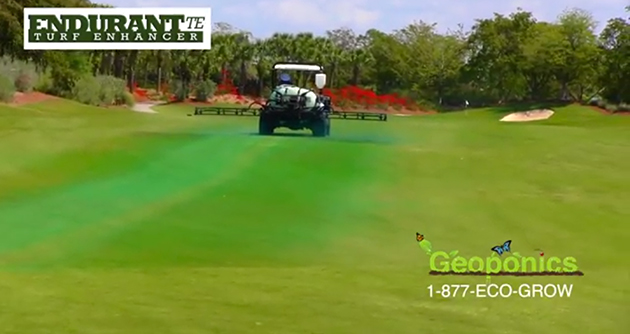Turfgrass Colorants, Part II: How golf course superintendents can transition from pigment to paint
This is the second part of a three-part interview with
Geoponics Corp and Justin White, of
WinField Solutions. White has approximately 20 years experience, or more, in golf course maintenance and turfgrass management.
[caption id="attachment_637" align="alignleft" width="630"]

Endurant TE is colorant used on actively growing grass for turf enhancement and as a spray indicator dye. www.TurfPaint.net[/caption]
Geoponics is the maker of
Endurant turf colorants, the #1 choice of turf colorants among professionals and fastest-growing brand of grass paint for homeowners.
Questions & Answers to assist golf course superintendents in successful use of colorants
Geoponics: In the previous article we discussed the benefits of colorants and some of the differences between pigments and paints. Pigments have been popular, especially Endurant TE, so when would you use a pigment vs. a paint?
White: Generally, golf course superintendents are seeing how well the Endurant TE pigments are working for them. When they lose some of the chlorophyl and want to consider transitioning into use paints instead of the pigment, they have to get accustomed to the
setup of the spray rig. Pigment and Endurant TE might be done every two weeks or so, or whenever needed as a
spray indicator dye. With Endurant TE on grass that has chlorophyll, it's less critical the setup of the rig and how it's applied than it is with paints, which are darker and often applied to grass that has less green color in it already.
Geoponics: Do you have any suggestions to assist golf course superintendents who are looking to transition from using Endurant TE pigments to using one of the Endurants paints?
White: Pigments are great while the grass is growing and it's not dormancy. When grass is going into dormancy, it's about to lose a lot of color, it's time to convert to paints, and then come back to pigment with the turf is heading out of dormancy.
Whether using paints on dormant turf or in different application rates for grass that has some color, it's important to know the right application method, volume, nozzles and the rig setup.
Geoponics: How do you pick the best Endurant color? What's your favorite to recommend?
White: The darker the color, the more critical it is the applicator know how to apply it for great results. The last thing you want is for someone to have a bad experience the first time they use a colorant. You want to love the contrast and get it right.
So, if the superintendent isn't that committed to the look, try a single application of Endurant PR with a slightly less noticeable rate with a once-over application even on straight dormant turf. If the golf course superintendent is a little more committed, then go with the darker Endurant FW, make two direction applications, modify the spray rig. They'll be even happier. They'll get more bang for the buck.
Read this article, which explores more tips for turfgrass professionals & advice on choosing the best colorant.
Geoponics: So, you're saying the color should not only match the season or grass, but even moreso match the goals, the turf and the variables present?
White: Yes. They need to set the time aside to paint when the golf course isn't in use too, whereas pigments take a bit less of a time commitment. I would make four main suggestions to golf course superintendents considering using colorants or switching between pigments and paints:
- Know the product.
- Know what you want and why. (This article might help.)
- Know how to adjust the spray rig for the look you desire.
- Once you get that product, make sure you know how to use it.
Check out the next article in the series, 8 tips using colorants on specific turgrass species. This next article will cover:
- Colorants used on various species of turfgrass, including tips on when to use pigments and when to use paints.
- Features and effects of using colorants on both cool season and warm season grass varieties.
- Water conservation, turfgrass dormancy and varying turfgrass conditions across climates.
 Endurant TE is colorant used on actively growing grass for turf enhancement and as a spray indicator dye. www.TurfPaint.net[/caption]
Geoponics is the maker of Endurant turf colorants, the #1 choice of turf colorants among professionals and fastest-growing brand of grass paint for homeowners.
Endurant TE is colorant used on actively growing grass for turf enhancement and as a spray indicator dye. www.TurfPaint.net[/caption]
Geoponics is the maker of Endurant turf colorants, the #1 choice of turf colorants among professionals and fastest-growing brand of grass paint for homeowners.